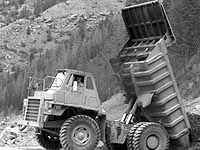| A rock truck dumps its load of earth in Crandall Canyon. |
When most people think of the construction business they think of, well, constructing something. But for the crews of Nielson Construction, sometimes it’s not a matter of constructing something, sometimes its a matter of erasing something.
Which is just what one Nielson Construction crew did as it recently completed the reclamation project on Crandall Canyon for Plateau Mining Corporation in Carbon County. In mid-November, with the project all but complete, there was little evidence of the fact that the canyon only recently was the home to two mine portals and other structures for Plateau Mining. The channel drainages had been restored to their original condition before the mine used the canyon and the portal shafts had been filled.
The project, which involved the moving of 120,000 yards of earth, began in early July. The demolition of buildings in the canyon was accomplished by a separate Nielson crew under the direction of Kimball Rassmussen and the backfilling of the mine shafts was accomplished by a Nielson Crew managed by Mark Greenhalgh.
“It was really a pretty straightforward job,” Greenhalgh said.
Although that proved to be the case, at the beginning of the job things were not so certain. The shafts at Crandall Canyon were developed as part of the Castle Gate Mine property and were sealed when the Castle Gate Mine was closed. Nielson Construction, working with Plateau Mining and the Mine Safety and Health Administration, followed a detailed plan for the removal of the caps on the shafts because it was unknown exactly what the methane gas content was in the two shafts. The plan called for the continual monitoring of the shafts after the caps were removed until the methane gas had reached a safe level. Fortunately, that didn’t take long. After removing the caps the methane gas quickly dissipated and the Nielson crews were able to get to work filling the shafts, which were more than 1,500 feet deep.
The earth work to reclaim the canyon began in September and culminated in Nielson crews “gouging” the relocated earth with the bucket of a track-hoe. Gouging the earth allows for a microenvironment to develop in the canyon and stops runoff. The seeds that are planted as part of the final part of the reclamation project are carried to the bottom of the holes made with the track-hoe bucket, where they can mature and germinate.
At the height of the project there were 12 Nielson employees working at Crandall Canyon. Mine reclamation projects can come with their own share of unique problems, which is where the experience of the Nielson crews paid off.

